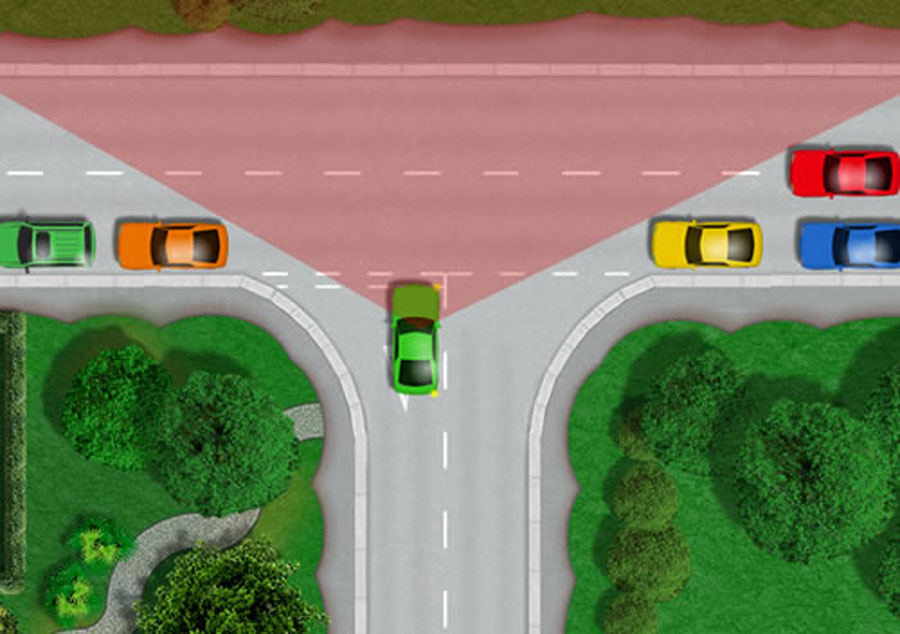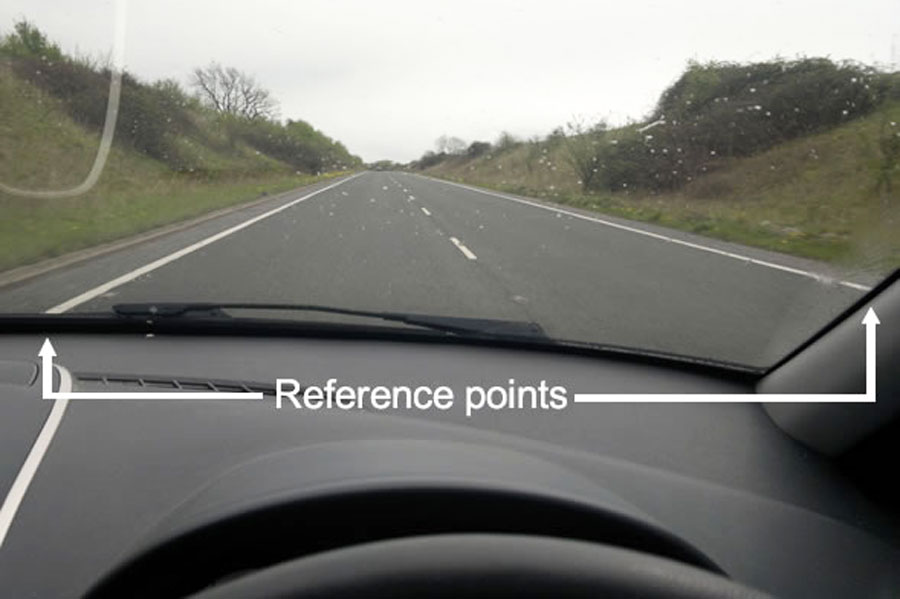Steer Clear of Failure: Top Common Driving Test Mistakes and How to Correct Them
Passing your driving test hinges on steering clear of key errors. Discover the common driving test mistakes that thwart hopeful drivers and learn straightforward strategies to dodge these pitfalls. Ready to pass with flying colors? Let’s navigate these challenges together.
Key Takeaways
- Staying vigilant with mirror checks is key for safety and passing the test. Remember the interior-to-exterior sequence!
- Approach junctions with the right balance of caution and observation, mastering both speed and blind spot checks.
- Keep your road positioning spot-on to avoid common errors. Aim to be the Goldilocks of lane placement—not too left or right, but just right.
Inadequate Mirror Checks

Mirror, mirror, on the car, who’s the safest driver by far? Those who understand the importance of frequent and timely mirror checks, of course! Mirror checks play a pivotal role in executing safe driving maneuvers such as signaling, changing direction, or adjusting speed. Examiners aren’t just looking for sporadic peeks in the mirror. They expect consistent, timely mirror checks throughout the driving test.
The secret sauce? It’s all about the sequence. Start with the interior mirror, then move on to the appropriate exterior mirrors. This sequence allows you to accurately judge the speed and distance of following traffic. But what happens when we slack off on mirror checks? Well, it could escalate to a Grade 2 fault, increasing the likelihood of a failed test. Insufficient mirror usage can compel other vehicles to modify their speed, thereby interrupting the seamless flow of traffic.
Junction Observations Gone Wrong
Now, let’s turn our attention to junctions – a common stumbling block for many learner drivers. A significant number of learners experience driver failing during their driving test due to ineffective left and right observations while approaching junctions. This is a major contributing factor to why they fail their driving test.
Junctions can be tricky, especially unmarked ones where no one has priority. These require effective and timely observation, careful observations, and a dash of caution. The stakes are even higher at closed junctions with restricted visibility – that’s when those ‘creep and peep’ techniques come in handy.
Usual mistakes at junctions include approaching either too swiftly or sluggishly, failing to identify the junction timely, and neglecting to check blind spots. These mistakes are particularly prevalent in areas like housing estates and T junctions.
So, when you approach a junction the next time, ensure to decelerate, observe, and then move forward.
Positioning Pitfalls on the Road
Positioning on the road is a bit like Goldilocks’ porridge – not too left, not too right, it’s got to be just right! Unfortunately, many learners don’t get it ‘just right’, which can lead to potentially dangerous situations, including:
- collisions or near misses with other vehicles
- difficulty navigating roundabouts
- difficulty merging into traffic
- confusion at intersections
It’s important to practice and develop good positioning and driving skills to ensure safe and confident driving.
Frequent road positioning blunders comprise unnecessary usage of the right-hand lane, not driving in the center of the road, improper “changing lanes” technique, and neglecting cycle lanes when appropriate. Point to note, by center we mean the middle of your lane, not the middle of the road! This error is surprisingly frequent among learners during the test.
So, how can we evade these positioning pitfalls? Here are some tips to help you stay correctly positioned on the road:
- Maintain a constant awareness of your surroundings and your vehicle’s location on the road.
- Drive in the middle of your lane to ensure you have enough space on both sides.
- Frequently check your mirrors to be aware of other vehicles around you.
- Remember, over half of driving test candidates fail due to simple positioning errors.
By following these practices and taking driving lessons, you can improve your positioning and increase your chances of passing not only your rsa driving test but also the driving theory test.
Safe Move-Off Mishaps
When it comes to moving off, the devil is in the details! It’s not just about hitting the gas and zooming off. A safe move-off procedure incorporates the MSM (Mirror Signal Manoeuvre) routine. This procedure guarantees that you inspect your mirrors, indicate your intentions, and execute a maneuver when it’s safe.
The six-point check is another crucial aspect. It includes examining:
- The left blind spot
- The left wing mirror
- The rear-view mirror
- The area in front of the car
- The right wing mirror
- The right blind spot
Remember, blind spots are the areas not visible in the mirrors, requiring you to look over your shoulders for a complete view around the vehicle.
During the test, ensure to demonstrate that you’re conducting the six-point check. Either physically move your head to look at each point or vocalize your checks. This explicit demonstration can go a long way in ensuring a successful move-off.
Traffic Light Troubles
Traffic lights – they might seem like simple red, yellow, and green lights, but they are the heart of road safety. Reacting appropriately to these lights is a crucial skill assessed during the driving test. Failing to react correctly to red lights, such as not stopping completely or even ignoring them, can result in an immediate driving test fail. But it’s not just about stopping at red lights. You also need to show awareness and decisiveness when the light is green. Hesitating or failing to proceed during a green light when it’s safe can negatively impact your test results.
Indeed, exhibiting indecisiveness by not moving forward on a green light while making a right turn at a junction, despite it being safe, can result in points being deducted from the driving test. So remember, traffic lights are not just about stopping and going. They’re about making safe and confident decisions based on the traffic situation.
Navigating Road Signs Right
Road signs and road markings are like the language of the road. They guide us, warn us, and help us navigate safely. But what happens when we can’t understand this language? Well, it can lead to failing the driving test.
Examiners anticipate that candidates will regulate their speed in response to the traffic signs. This means neither driving too fast nor too slow, reflecting the importance of responding to speed limit changes.
One common mistake during a driving test is ignoring ‘stop’ or ‘no entry’ signs, as well as speed limit changes. Incorrect use of bus lanes when the time is displayed can also lead to penalties. So, to navigate the road signs right, take some time to brush up on your knowledge. It’s like learning a new language, the more you practice, the better you get!
Turning Right: Proper Positioning
Now, let’s address the right turn. It may appear straightforward, but a number of learners struggle with correct positioning while making a right turn. This can cause traffic obstruction and delays.
The correct position for turning right on a two-way road is just left of the center of the road. This positioning allows traffic coming from behind to pass safely on the left when the road is wide enough.
When preparing to turn right, position the vehicle close to the white line in the center of the road. If you need to stop while making the turn, align the vehicle approximately with the middle of the road into which the turn is being made.
After completing the turn, promptly return to the normal driving position on the left side of the road to maintain proper traffic lane discipline.
Gaining Control When Moving Off
Moving off can be a nerve-wracking moment, especially during a test. That’s why maintaining control while moving off is of utmost significance.
To prevent stalling the vehicle when moving off, it’s crucial to find the biting point and gradually apply the accelerator. Hill starts can be particularly challenging for learners. Incorrect execution can result in the car rolling back, posing a risk to safety and control.
Selecting the appropriate gear is another critical aspect of using your car properly. It ensures that the vehicle moves off smoothly without stalling or losing control. So, the next time you’re moving off, remember – control is key!
Steering Mastery: Avoiding Common Errors
Steering is the most direct aspect of driving (pun intended!). But many learners fail their test due to lack of proper control when steering. Feeding the steering wheel smoothly and evenly through the hands is key to maintaining control after turning. Maintaining both hands on the steering wheel in the ‘ten to two’ position helps manage better control.
Remember, overconfidence can lead to a lack of steering control. So, avoid common mistakes like using the steering wheel with just one hand, crossing your arms when turning the wheel, or attempting a steering wheel fly. Steering mastery is all about balance and control.
Reverse Parking Perfection
Lastly, but certainly not the least, comes reverse parking. It’s the grand finale of the driving test, and perfecting it can make all the difference. Common errors during reverse parking include ending up outside bay lines, taking too many attempts, or having wheels on the pavement. But fear not, control of the vehicle can be maintained by mastering clutch control in manual cars and by using brakes carefully in automatic cars.
To better your reverse parking skills, there’s nothing more effective than practice. Here are some tips to help you improve:
- Undertake mock driving tests
- Try difficult maneuvers
- Arrive early before the test to reduce stress
- If things don’t go as planned, take corrective actions
- Adjust the vehicle’s position within the bay lines
- Ensure not to rush the maneuver Remember, slow and steady wins the race!
Summary
As we cruise to the end of our journey, let’s remember that knowledge is power. Understanding the common pitfalls of a driving test helps you steer clear of them. Whether it’s mirror checks, junction observations, road positioning, or steering control, every aspect plays a crucial role in acing that test. So, buckle up, hit the road, and remember – practice makes perfect!
Frequently Asked Questions
What is the most common mistake in a driving test?
The most common mistake in a driving test is not stopping the car at the line, so make sure to come to a complete stop when required. This is crucial for passing your test.
Why is checking mirrors important during a driving test?
Checking mirrors is important during a driving test because it ensures safe signaling, changing speed, and direction, and helps avoid forcing other cars to slow down. It’s a crucial part of safe driving.
What are some common positioning errors on the road?
Some common road positioning errors to avoid are using the right-hand lane unnecessarily and not driving in the middle of your lane. It’s important to stay aware of your positioning to ensure safety on the road.
What are the common mistakes made when responding to traffic lights?
The common mistakes when responding to traffic lights include not stopping completely at red lights and hesitating to move on a green light when it’s safe. Be mindful of these to ensure safer driving.
How can I improve my steering control?
To improve your steering control, always keep both hands on the steering wheel, make smooth and even steering motions, and be cautious about overconfidence. This will help you maintain better control of your vehicle.


